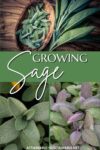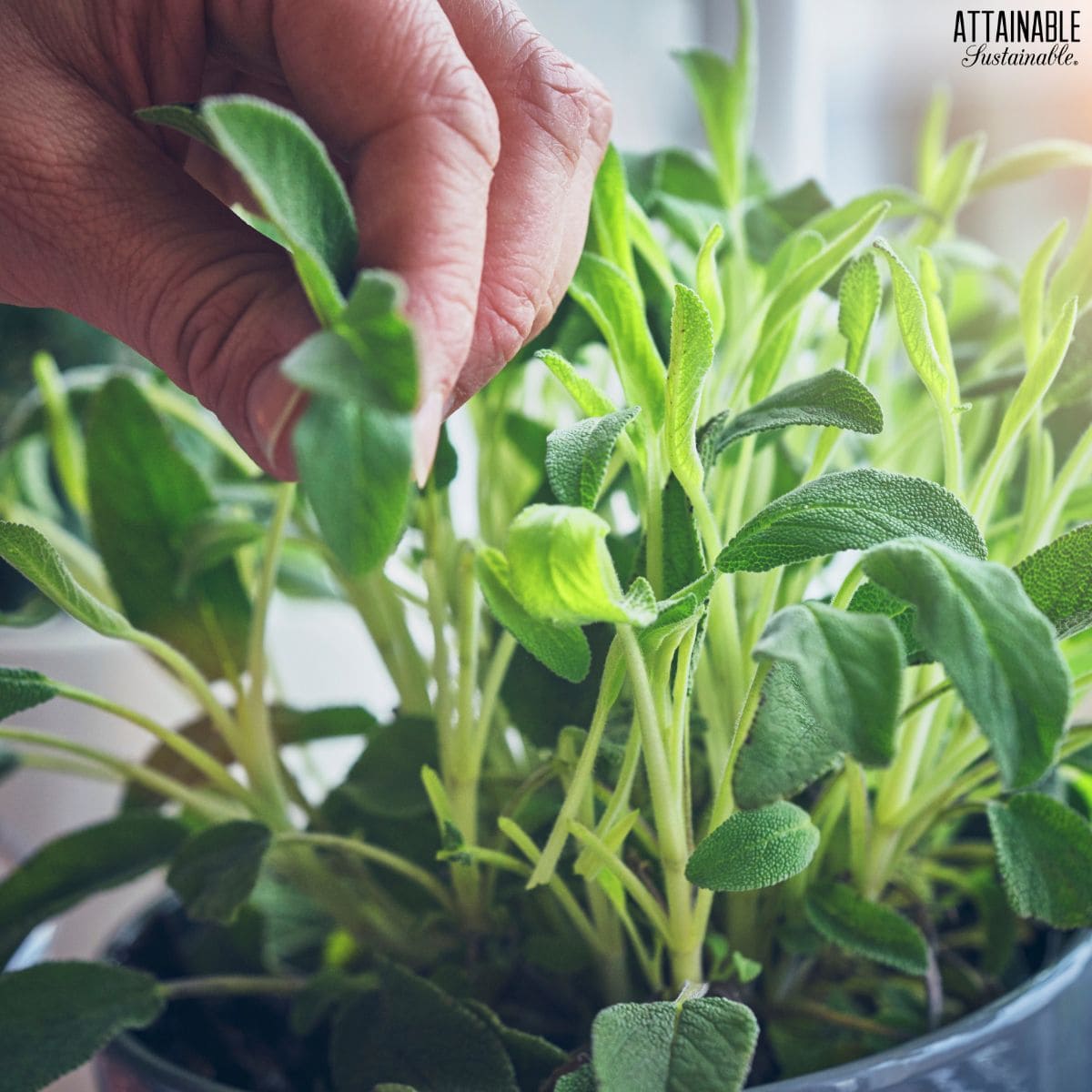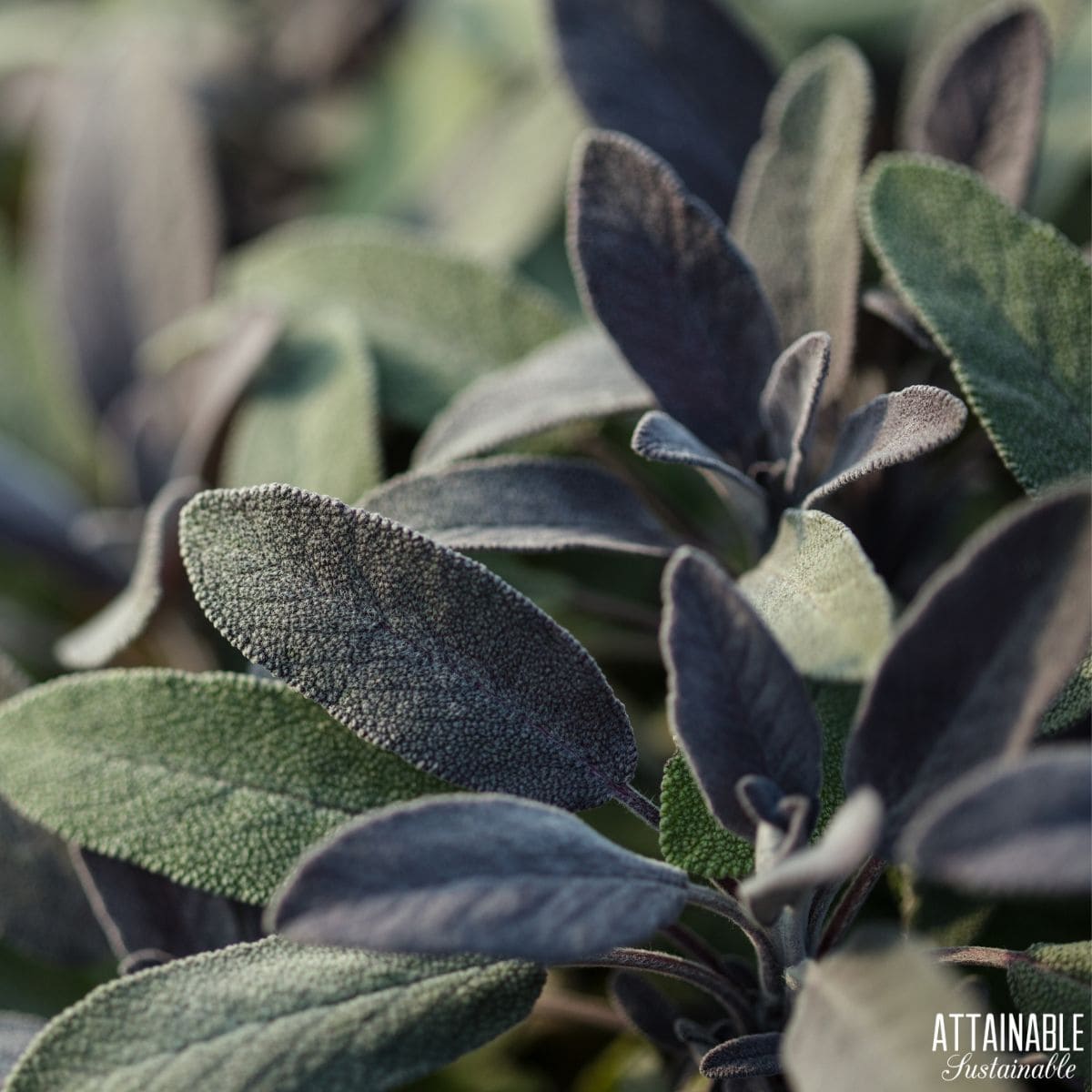Growing sage in your herb garden adds a unique and pretty plant that looks as good as it tastes. Known for its fuzzy leaves and accompaniment to savory recipes, sage can also switch things up in a salad and be used as a medicinal herb. With a delicious flavor and smell all of its own, as well as its ability to attract pollinators, growing sage is an asset to your garden and health!
You might also be interested in growing mint in your herb garden!
Contributed by Jodi Torpey, author and Master Gardener.
Garden sage is a culinary herb believed to have originated in the Mediterranean. This ornamental and aromatic plant has a long history of use in cooking and as a medicinal herb. Some horticultural historians believe garden sage (salvia officinalis) gets its name from the Latin word for safe, referring to its use as an antiseptic and anti-inflammatory herb.
Sage is probably most familiar to gardeners as an herb with multiple uses in the landscape. Garden sage has narrow or broad slightly fuzzy gray-green leaves that are used fresh or dried in savory recipes. But the plant also looks at home as an ornamental in raised beds, perennial gardens, and container gardens.
Among sage’s nice features are the late-summer flowers that grow on long upright spikes in colors from white to pinkish-blue to dark blue. The flowers attract bees and other pollinators, plus they’re tasty additions to summer salads.
Grow Some Greens!
Ready to grow fresh greens, no matter WHERE you live? Sign up for my
FREE quick-start guide and start growing some of your own food!
Sage plants can be perennial in warmer climates and can grow to 1-2 feet tall and 2 feet wide. The plant’s pungent aroma and deep flavor make it a must-grow herb for gardeners who use it as a key ingredient in Thanksgiving stuffing.
Sage also goes well with other herbs, both in the garden and in recipes. Good combinations include planting with rosemary, thyme, oregano, and parsley.
Plant a Variety of Sage Types
Garden sage is sometimes called common garden sage or kitchen sage. When shopping for sage varieties to use in your cooking, select garden sage instead of flowering ornamental salvia types. For added interest, look for sage varieties that have variegated leaves.
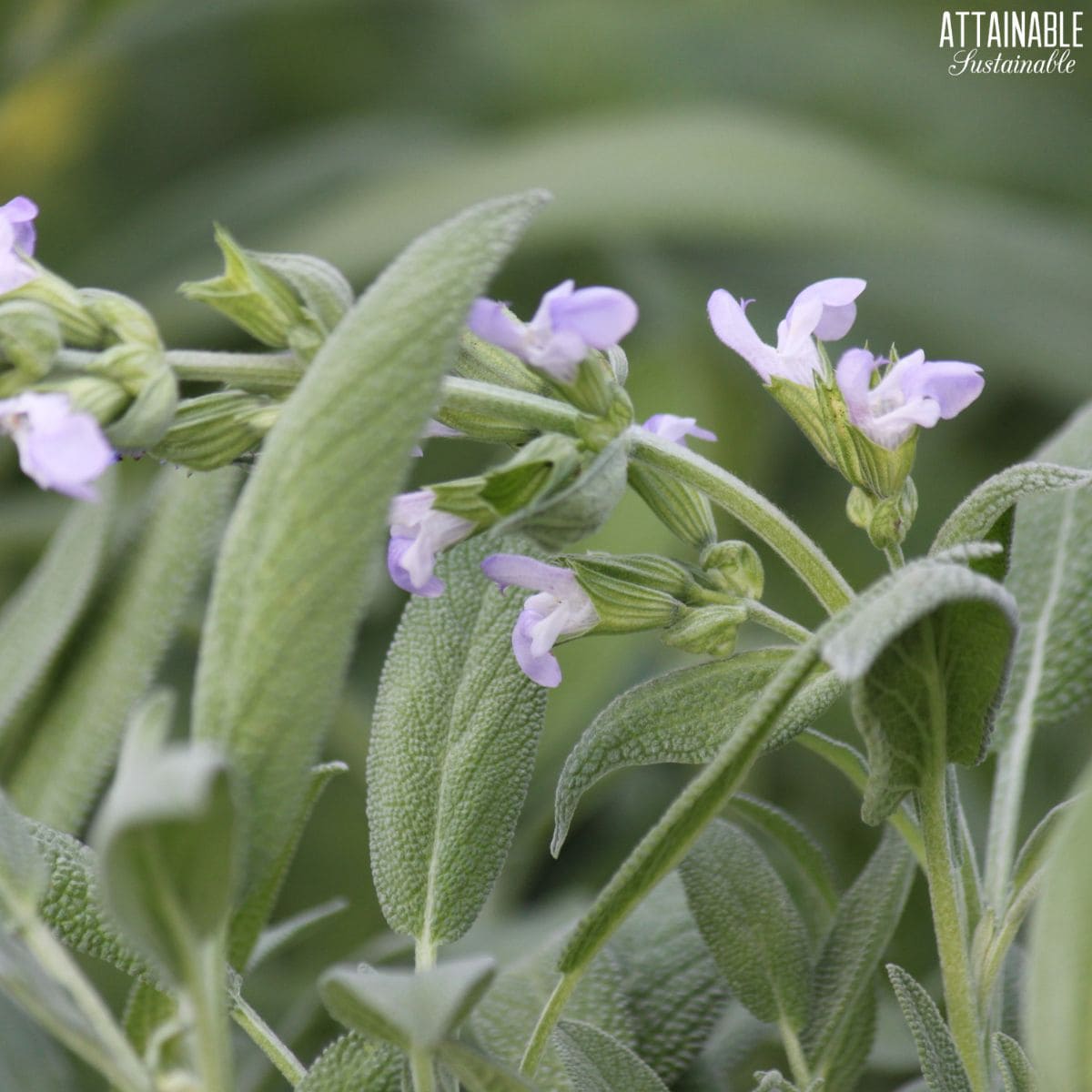
The flowers of garden sage are pretty in the landscape.
Like other herbs, sage leaves are ready to use when they’ve grown large enough to clip from the plant. Here are some popular garden sage varieties for planting in your garden:
Berggarten has the familiar large, oval-shaped dusky green leaves that cook’s prize in the kitchen; can be hardy in zones 6-10.
Icterina is a golden sage, a small compact plant with light green-yellow leaves. This sage makes a nice annual in cooler zones.
Purple leaf sage (Salvia officinalis purpurascens) offers leaves that become soft and have a deep purple color; grows as an annual in cooler regions.
Tricolor sage has interesting and colorful leaves. While not a winter-hardy sage in planting zone 5, tricolor makes up for it with leaves that are green and pink with white edges.
Pineapple (Salvia elegans) has a sweet, fruity scent. This sage variety needs moist soil and with the right conditions can grow to 4 feet tall; features brilliant red flowers in late summer.
New to gardening? Limited on space? The 5-Gallon Garden gives you the skills you need to grow food in the space you have. Get started with your garden today!
How to Grow Garden Sage
Common sage can be a hardy perennial or annual plant depending on winter temperatures. Sage is one of the herbs that aren’t fussy about soil conditions. This herb likes a warm, dry spot that gets plenty of sun. Make sure the planting site allows for water to drain off quickly. Too much water causes problems with the roots.
While you can grow sage from seeds, it will take longer to get to a full-size plant than using cuttings or transplants. If you want to start seeds, plant them indoors 10 weeks before the date of the last frost in your area. Seeds may take 3 weeks to germinate.
Sage transplants that start out small will grow into large plants, so space sage plants at least 8-12 inches apart and 12-24 inches apart in rows in well drained soil, depending on the variety.
Space holes and place a sage transplant in each hole at the same level it was in its container. Gently firm the soil around the plants and water in. Add a layer of organic mulch to help regulate soil temperature and to keep soil from drying out too quickly.
Prune plants in spring to encourage new growth or pinch back new growth to create bushier plants.
Requirements for Growing Sage
Soil Requirements
Sage plants prefer soil that drains well, especially if plants are grown to overwinter. Dig in compost to make well draining soil to keep plant roots from sitting in pools of water.
Light Requirements
Plant sage in open full sunny areas, although sage can also grow in partial shade conditions.
Fertilizer and Water Requirements
Sage won’t require much additional fertilizing, maybe once or twice over the course of the season. If growing in containers, a liquid soluble fertilizer added to the water every few weeks will give plants a boost.
As far as water requirements, sage is less fussy than other herbs. You can cut back on the water once plants are established, although be sure to keep plants from wilting during the hottest and driest times of the year.
Preventing Problems with Growing Sage
As with other herbs, there are few pest and disease problems with sage. Most issues have to do with environmental conditions, such as too much or too little water or planting too close together. Once established, be sure to keep soil on the drier side to prevent problems such as root rot.
Be sure to give plants plenty of room to grow and for air to circulate to prevent possible problems with powdery mildew or other foliar diseases.
Watch for any insects, such as spider mites, and use a forceful spray from the garden hose to wash them away.
Growing Sage in Containers
Sage grows well when planted in large containers with drainage holes in the bottom. Plant one plant per container.
Fill containers with a good-quality potting mix designed for outdoor container growing. Mix in a slow-release plant fertilizer and for fast growing, use a sage transplant. Place the plant in the container at the same level it was in its pot.
Water in and keep the soil moist until sage begins to grow. Keep up with watering when the top few inches of soil start to dry but avoid soggy soil or soil that dries out completely.
Plants in containers can be moved inside to a sunny window for winter and then moved outside once the weather warms.
How to Harvest Sage
For more pungent sage leaves, clip off flowers as they appear and before flower stems start to grow.
You can start cutting and using individual leaves for cooking as soon as the plants are large enough. You can also snip 6–8-inch-long stems to bring inside to hang for drying in a warm, well-ventilated area.
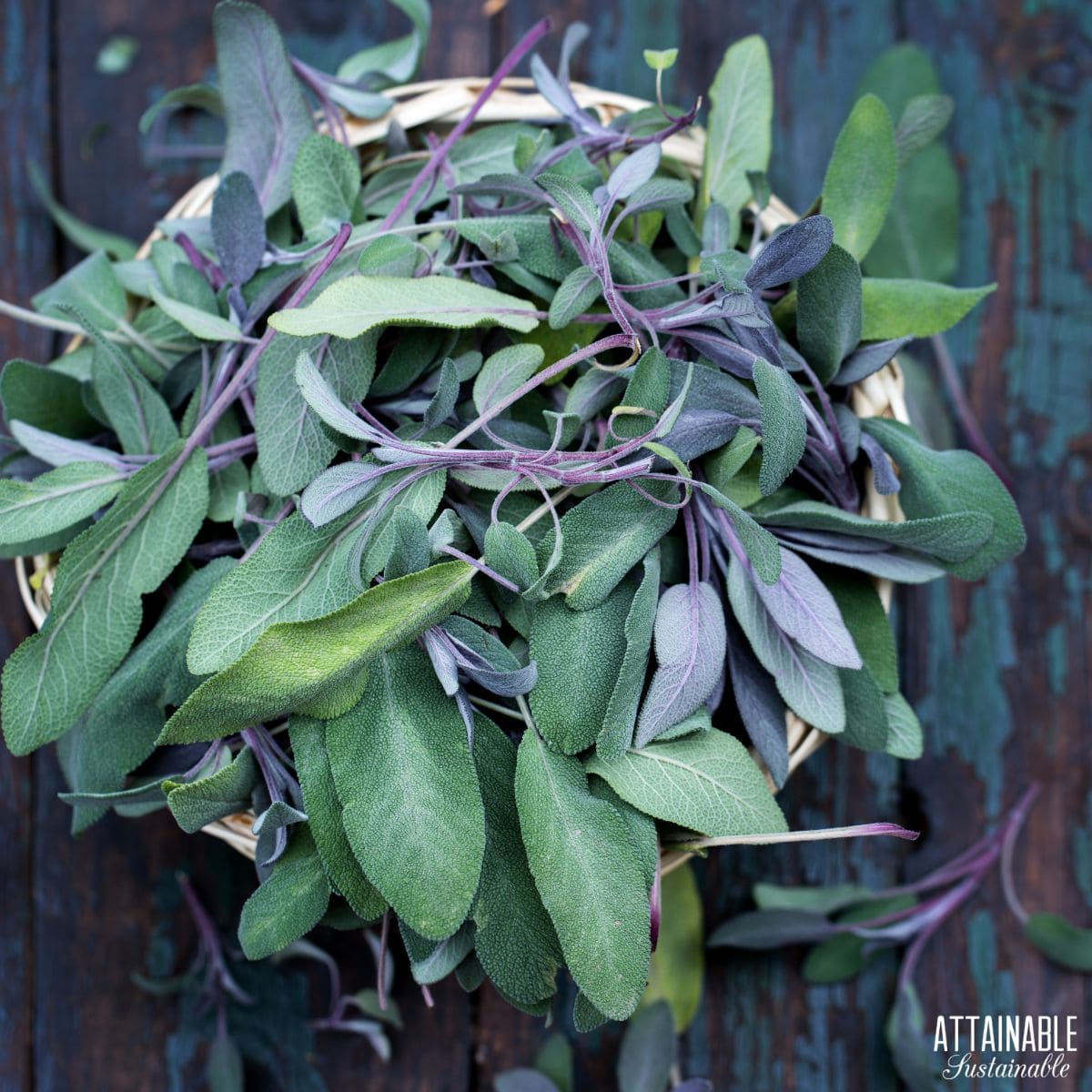
Clip sage leaves individually for cooking, or harvest bunches to dry
How to use Sage in the Kitchen
Use only blemish-free sage leaves that have good color and are aromatic. Refrigerate fresh leaves for up to a week in a paper towel and sealed baggie and rinse before using.
For dried leaves, store them in a cool dry place as whole leaves and crumble or grind right before using. Dried leaves need to be stored in tightly sealed containers so they retain their flavor and color.
Sage is the main ingredient in poultry seasoning and it makes for a fine way to spice up dressing or stuffing for turkey or chicken. Sage can also be used fresh in pasta sauce or mixed into meatballs. Add to soups, sprinkle dry crumbled sage into bread doughs, put into grilled cheese sandwiches, and use to spice up pork dishes.
How to Propagate Sage
To propagate garden sage, you can take cuttings from established plants. Cuttings can be taken from plants in summer and rooted in small, individual pots.
Keep soil moist and allow 6-8 weeks for plants to root. You can keep plants in a sunny window over winter and then move them outside the next spring.
